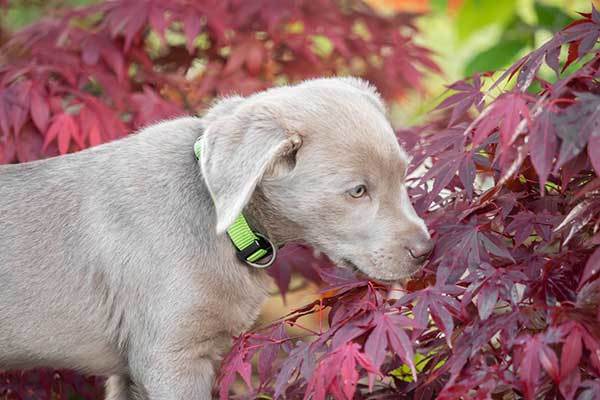The American Kennel Club (AKC) and other kennel clubs have registered only three variations of the Labrador Retriever breed: Black Labrador, Yellow Labrador and Chocolate Labrador.
Black Labradors come in a uniform black color while chocolate Labs range from a light chocolate to dark brown.
Yellow Labs come in an amazingly wide variety of shades, from nearly white, to butterscotch and cream to slightly dark red.
However, there is a relatively new color of Labrador Retrievers recognized and loved by some breeders, but disputed by others. That new addition is the Silver Labrador Retriever.
Silver Labrador Retrievers are quite new in the canine world. As they gain popularity though, more and more people want to know what makes these dogs special.
In this guide, we’ll take a closer look at the Silver Lab and answer all of your questions about these striking dogs.
Read on to learn everything there’s to know about the Silver Lab so you can determine whether this dog is a good match for you and your family.
Table of Contents
What is a Silver Lab?
Black, chocolate and yellow are the Lab colors recognized by the AKC.
Recognized shades of the Yellow Labrador Retrievers can range from butterscotch to pale cream and even slightly dark red.
While there’s no variation for the black Labradors, Chocolate Labs previously came in variations of medium or dark brown. Nonetheless, this changed with the appearance of the Silver Lab on the scene.

? The Silver shade is not a different color, but it’s a dilute variation of the Chocolate Labrador Retriever. The word “dilute” here is used to refer to a gene that creates a lighter hue.
When it comes to Silver Labrador Retrievers, some will be Silver or gray while others will be a lighter version of brown. That’s why the AKC classifies them as chocolate Labradors.
The Origin of the Silver Lab
The British Kennel Club recognized the Labrador Retriever as a unique breed in the year 1903 and the AKC followed suit in 1917.
Prior to this, no dog breeder had ever registered Silver Labs, but they were happy to record many other Labradors that deviated from the common colors such as tan, black, yellow and chocolate.
Out of nowhere, Silver Labs were documented in the 1950s as “rare gray Labs for sale”.
But where did Silver Labs really come from?
Labradors were originally developed to be gun dogs. They used to accompany their owners on hunting missions and would “retrieve” the animals that had been shot.
Wealthy families owned St. John water dogs in the 19th century. With selective breeding practices, they developed the Labrador Retriever as we know the breed today. Their loyalty, soft mouth, speed and retrieval skills enabled them to excel at this role.
The Lab’s great personality traits soon had families taking them home as companion pets. Soon after, they become one of the most popular dog breeds in the world.
But how did the Silver Labrador come about?
Well, this is a major topic of discussion in the canine world. Some dog experts and breeders claim that Silver Labs were bred on purpose.
Others claim that these dogs were created naturally in the United States sometime in the 1950s after a dominant color gene emerged.
Is The Silver Lab Related to Weimaraner Dogs?
? The Silver color in Labs is due to the dominant gene “d”, which is also present in Weimaraner dogs.
Also, some Silver Labs have ears that resemble those of Weimaraner dogs. That’s why some people believe that Silver Labs are a cross between the Weimaraner dogs and Chocolate Labrador Retrievers.
However, there’s no evidence that crossbreeding actually took place. If breeders kept crossbreeding the two dogs for the purposes of getting a certain color, then the purebred Lab would become extinct.
View this post on Instagram
Is The Silver Lab Dog Pure Bred?
As we’ve mentioned above, there’s no evidence that Silver Labs were developed by crossbreeding, but even if that was the case, that should not necessarily be an issue when it comes to the health of the dogs.
However, some breeders are concerned about the breed’s future. Others are worried about the impact of a genetic change without proper consideration.
Pedigree dog breeders are open to the notion of closed registry breeding. However, there are still many concerns regarding closed registry breeding, making this a very controversial topic with strong arguments on both sides.
Are Silver Labs Inbred?
Inbreeding is associated with certain issues, which make it a thorny issue for those who are concerned about canine welfare.
Inbreeding tends to increase the risk of various health issues developing or becoming worse.
When an abnormal or rare color gains popularity, there is an increased chance of inbred puppies being created. While no one should underrate the Silver Lab population, inbreeding is no longer the big deal that it once seemed to be.
It is important to note than any negative impact of inbreeding can be counteracted by facilitating a low co-efficient of inbreeding between the parent dogs of each litter. A well-informed breeder can help you understand this better.
View this post on Instagram
Is the Silver Lab Recognized By the AKC?
If you’re considering owning a Silver Lab, you may want to know whether this dog is recognized by the American Kennel Club (AKC).
The simple answer is yes! Silver Labs are recognized by the AKC but are classified as Chocolate Labs. They are not classified as Silver Labs since this color is not officially recognized.
However, the decisive factor for registration is that the dilution gene should not be present and that the dog should have all the known traits of Labrador Retrievers.
ALSO READ: All About the Miniature Labrador
What Does a Silver Lab Look Like?
The only way that Silver Labrador Retrievers differ in appearance from other Labs is in their coat color.
There’s no denying the fact that Silver is attractive, even in Lab puppies. The Silver color can be metal or gunmetal gray in appearance.
Labs are medium sized, well built dogs. These dogs have a large head, thick tail and a short, thick coat.
Silver Labrador Retrievers are gray (just like Weimaraner dogs). They have gray noses, gray nails and gray pads on the feet.
View this post on Instagram
What Color Eyes Do Silver Labs Have?
Silver Lab puppies have light blue eyes until they are around 6 to 8 months old. Full grown Silver Labs have pale yellow eyes (which is partially the tone of the eyes of a chocolate Lab).
Their highly friendly eyes show their good temperament and high intelligence levels.
How Big Does a Silver Lab Get?
The Labrador Retriever reaches up to 24.5 inches in height for a male and around 23.5 inches for a female. Nonetheless, individual dogs can vary in height.
When it comes to weight, variations can be large and will usually depend on which of the two categories (English or American) your Silver Labrador Retriever falls into.

Male Labradors weigh around 70 pounds while females are around 10 pounds lighter.
However, there can be as much as 20 pounds difference when it comes to the weight of individual Labs.
American Labradors developed for hunting are taller, slimmer and sometimes lighter than the English Labs that are bred for shows.
Coat Color
For this dog, the coat color is often the cause of controversy. Some people believe that Silver Labs are not purebred Labradors. They think that the “d” gene was inherited from the Weimaraner dog breed.
As we’ve seen, the AKC considers them to be chocolate Labs and although they can be registered, they are not considered to be a unique breed in the US.
They are also said to be charcoal Labradors and that is also subject to debate.
The coat colors of Charcoal and Silver Labs are a result of a dilute gene (the “d” gene), which is passed on to the next generation. This recessive gene also contributes toward the color of the Chocolate Labs and the Champagne Labs as well.
View this post on Instagram
However, breeders say that they have total control over the color of these dogs coat since they can prevent this dilute gene from being passed on to subsequent generations by carefully selecting the parent dogs.
And now, let’s delve into the science behind the Lab’s coat color.
You might be familiar with dominant and recessive genes from your school studies, which explain the inheritance of certain characteristics.
Dominant genes are more powerful and tend to express themselves even in the presence of a recessive gene. Recessive genes are less “influential” and tend to express themselves when there are two copies of the recessive gene present.
For example, blue eyes in humans can be said to be a recessive gene. Therefore, a blue-eyed child can only be born to parents with blue eyes or when both parents are carriers of a recessive gene regardless of the color of their parents’ eyes.
This implies that two black eyed parents have the potential to bear a blue-eyed child. If both parents are carriers of a recessive gene for blue eyes, they have a ¼ chance of getting a blue-eyed child.
View this post on Instagram
Likewise, a Lab’s coat color depends on certain genes that are turned on and off.
The genes that determine coat color in Labradors are the “B” and “E” genes. On the other hand, the “A” genes are responsible for giving the coat of a dog a solid color while the “T” gene ticks to be turned off at all times.
Every Lab puppy carries two “bee” genes, which are inherited from each parent.
The dominant “bee” gene is responsible for the black coat color while the recessive “b” gene causes a brown or chocolate coat color.
There are three different sets of “bee” genes, which a Lab puppy can inherit from each parent dog. These are BB, Bb and bb.
View this post on Instagram
At the same time, the “Eee” genes work as an epistatic or masking gene.
The dominant gene (“B”) does not hinder the bee genes. The recessive “e” gene can potentially turn off or mask the dominant “bee” gene, which would otherwise produce the brown or black coat. The outcome is a yellow Lab.
There are three different sets of Eee genes in Labradors. These are EE (two dominant genes), Ee (once from each) and ee (two recessive genes).
Simply put, if the parent dog has EE or Ee (non-yellow coat color – which could be chocolate or black), the coat color will depend on what is present at the dominant B gene.
If there’s a recessive yellow color gene i.e. ee, then the coat color will be a yellow regardless of what is present at the B gene. A yellow that has a BB or Bb (a dominant B gene) will normally have black coloration on the lips, nose and eye rims.
But what really causes the Lab’s Silver coat?
Genetics can help us understand what makes the Lab’s coat Silver, but it cannot tell us exactly where it came from.
Now, the Silver shade occurs when the “D” gene is turned on. In case the “D” gene is present in its homozygous form (the recessive “dd”), then it can dilute the “B” gene coloration.
Gene combinations usually determine a puppy’s color. This is genetics and it helps us to predict what coat color we should expect in any combination of canines.
Gene Combinations
When it comes to Labradors, nine gene combinations are possible:
• EEBB, EeBB, EEBb, & EeBb = a black Lab.
• eeBB, eeBb, & eebb = a yellow Lab.
• Eebb & EEbb = a chocolate Lab.
? Since there are more possible gene combinations that can result in the black color, there are more black Labs around than chocolate or yellow.

So, every Labrador has two pairs and one of the allele from each pair will be passed on.
For instance, a black Labrador with the genetic composition of EEBB will normally pass on one B and one E allele. If the black Lab has the genetic composition of EeBb, the dog will pass on a B or b and an E or e.
If both parent dogs are yellow Labradors, irrespective of what the B alleles are, the puppies will always be yellow. On the other hand, two black Labs could produce black, yellow and chocolate Lab puppies.
ALSO READ: Golden Retriever Vs Labrador – Which Is The Best Pet?
The Dilute Gene
Labs have another gene pair that does not determine coat color. This pair comprises the “D” allele and its recessive “d’ form. Traditionally, this pair is usually DD.
For a Labrador to have the Silver coat that has become extremely popular in recent times, this DD pair should have two recessive alleles (dd), which leads to the dilution of the solid color.
View this post on Instagram
Ultimately, there are three possible outcomes in a Lab:
• DD will always be a solid color (black, yellow or chocolate).
• Dd will also be a solid color (black, yellow or chocolate), but a dog with this pair can sire dilute color pups if he mates with a canine with either Dd or dd gene.
• dd will always result in a dilute color. A DD and a Dd will result in no dilute color puppies in the litter. However, if the dd mates with a Dd, some puppies may have the dilute color.
The Silver Labrador Retriever is a chocolate Lab that has the dd gene. If a yellow Lab has the dd gene, its dilute color is known as Champagne. If a black Lab has the dd gene, the puppy will have the charcoal appearance.
Are Silver Labs Rare?
Since Silver is a fairly new coloration in Labs, Silver Labs are quite rare. These pups are also rare in some countries because their registration is not permitted.
However, Silver Labrador Retrievers are not uncommon in the US where they are registered under the chocolate color.
While not particularly rare, Silver Labs can be more difficult to find than yellow, brown or black Labs.
ALSO READ: All About The Dalmatian Lab Mix (Dalmador)
Silver Lab Temperament
Firstly, the Silver Labrador temperament is best suited to an active family. These dogs are friendly and very happy to be around their owner and family members.
Just like other Labs, Silver Labs are good-natured and once they get used to young children, they will be great playmates for them.
View this post on Instagram
In addition to their sociability, they are also very loyal to their family.
A Silver Lab will not hesitate to come to the rescue of his owner, if need be. Labs are known for their intelligence, fearlessness and loyalty. It is these traits that make them so appealing to dog lovers around the world.
While Labrador Retrievers of all colors are non-aggressive, any breed can be influenced by both genetics and the environment. That’s why proper training and early socialization are extremely important for any dog.
But does the coat color affect temperament? let’s find out:
Does Coat Color Influence Temperament?
There seems to be little to no evidence that coat color can affect the personality traits or behavior of a dog. However, the working gun dog community has a very strict opinion on this.
People who use Labradors as gun dogs consider black Labs to be the best for the role. Yellow Labs come in second place but they are not regarded as the best. Chocolate and Silver Labs are considered to be show dogs or simply companion dogs.
Regardless of coat color, the incredible working ability of Labs has been nurtured and refined over the years.
Not only is this hardy and happy dog the most popular companion dog in the US and the UK, he is also the most popular retriever dog in the world.
View this post on Instagram
Behavior With Strangers
Most Labrador Retrievers are friendly towards people. They will only bark when a stranger comes to the home, but they form trusting relationships quiet fast. This is a very friendly and trusting dog.
Behavior with Kids
Labrador Retrievers are among the best dogs for young children. However, keep in mind that Lab puppies can be very enthusiastic, often jumping up on children with vigor.
If your Lab puppy tends to jump up on people, you should try and stop this behavior as soon as possible. Jumping can harm children and even adults. Moreover, it can put the dog in a elevated state of excitement, which is bad for him.
Behavior with Other Dogs and Pets
Most Labs get along well with other dogs and animals. They are fine with cats, livestock and small pets like ferrets and rabbits.
Of course, early socialization is extremely important. Don’t just place your little pet into a room and let your adult Lab dog loose in the same room. Even a very friendly dog can injure or even kill a fragile pet by simply jumping on it.
View this post on Instagram
Training
Silver Labs are very intelligent. They have the potential to learn new tricks and will usually remember those tricks forever. However, the key to getting your Silver Lab puppy to obey you is to start training them as soon as you bring them home.
By instilling obedience into your Labrador puppy from an early stage, you will be teaching them good manners before they become accustomed to the bad ones.
Aspects like housetraining, heeling and sitting are very important in the early stages of your puppy’s life. You can still successfully teach your dog these commands at an older age, but he might not be as keen to learn, particularly if he is used to bad behaviors.
Labs, like Golden Retrievers, will respond well to treats, praises and other positive reinforcement training methods. These food-motivated dogs will learn fast if treats are part of training.
Use treats to teach your puppy basic commands such as come, sit and down. You can also use a clicker to help your puppy recognize acceptable behavior.
The most important thing when teaching your dog new tricks is consistency and patience.
Of course, potty training should be your first priority and it is advisable to start training your puppy at a young age. Once they get older, it would be more difficult to teach them even the basics.
Avoid using aversive training methods like punishment. It is widely known that these methods can actually create and worsen behavioral issues in dogs.
Exercise Needs
Another thing you need to keep in mind is exercise. Your Labrador Retriever will need plenty of it.
If your Silver Lab dog does not get enough exercise, he will most likely get bored and develop destructive behaviors such as overturning items, destroying shoes and jumping up on people.
View this post on Instagram
Labradors are generally best suited to active families since they are definitely passionate athletes.
Prepare to exercise and walk your dog at least 60 minutes each day with more time spent playing and training. Your Lab will also be happy to accompany you on hikes up the hills or through the fields.
Thanks to their history of being retrievers, Labs also enjoy swimming and the outdoors.
As long as you keep up with your pet’s training and exercise needs, you will certainly achieve the desired results. Labs tend to learn quickly and your Silver Lab should be your new best friend in no time.
ALSO READ: The Top 15 Best Treat Dispensing Toys for Dogs
Grooming
Being a Labrador, a Silver Lab sheds seasonably and requires proper grooming on a regular basis.
Brush your dog’s coat at least twice per week to reduce the shedding and to remove any loose hairs.
Trim their nails periodically to avoid overgrowth. Check their ears regularly for infection. Clean their outer ears using a moist or damp piece of cloth. Remember to check their eyes regularly, as well.
Bathe your dog at least once every two months and periodically during the shedding season. It is also best to brush your pup’s teeth daily.
Giving your dog a positive grooming experience will help keep him happy and healthy.
Related: What Is The Best Brush For Shedding Dogs? (Top 15)
Feeding Information
Many dog owners wish to feed their best friends the best food available out there. However, it can be difficult to choose the best food brands available today. Consult your vet before picking a food brand for your new puppy.
Start giving your dog dry kibble once they reach around 8 to 9 months old. Most Labs have a huge appetite, so be sure to monitor their food intake from the time your bring him home.
View this post on Instagram
Lab puppies should be fed around 4 times per day while full-grown Labs should be fed just two times. For small puppies, split the food into four smaller meals and maintain a three-hour gap between meals.
? Most Labs weighing around 60 pounds should eat around 4 to 5 cups of high quality dog food each day. Be sure to split the food into two meals each day.
Do not overfeed your Silver Lab puppy in order to avoid obesity.
How Long Do Silver Labs Live?
The average Silver Lab lifespan is around 12 to 13 years. However, since Labradors are a healthy breed, if taken proper care of, these dogs have the potential to live up to 20 years.
But do Silver Labs have health issues? Let’s find out below:
Silver Lab Health Problems
Overall, Labs are generally healthy dogs. Due to their small genetic pool, however, Silver Labs have some well known health issues.
With these dogs being less common than other variations, their genetic pool is considerably smaller than other Labs. This leads to inbreeding, which ultimately causes some major health conditions.
However, this issue isn’t unique to them. Many pedigree dogs are a result of inbreeding and come with some major health issues due to it.
View this post on Instagram
While purebred dog fanciers may get upset when this fact is pointed out, it is a major cause of concern. The overall health of some of these pups might not be as good as many mutts or mongrels.
Even so, Silver Labs are prone to the same health problems experienced by other Labrador Retrievers. These include eye problems, elbow and hip dysplasia.
If you want to get your Silver Lab puppy from a dog breeder, make sure you check their hip and elbow scores. You also want to get their eyes checked.
Moreover, due to their untypical coat, Silver Labs can suffer from a certain type of alopecia known as color dilution.
While this is not a life-threatening condition, it means that their hair may fall out when they are still young. This may also be accompanied by infections of the hair follicles.
Remember, Labs are prone to obesity, so avoid giving them too many treats or snacks.
How Much Is a Silver Lab?
Since Silver Labs are relatively rare, they can be quite expensive. The average Silver Lab price is around $1,200.
Avoid buying cheap Silver Lab puppies since you are likely to get a unhealthy puppy that is a result of poor breeding methods.
View this post on Instagram
Silver Lab Breeders
When you are considering Silver Labrador puppies, the most important thing is to do business with a reputable breeder.
A good breeder follows responsible breeding practices and has a track record of the healthiest Silver Labs ever bred.
There are reputable breeders who have Silver Lab for sale that are fully health tested. However, you may have to wait since this coat color is growing in popularity.
Once you meet the Silver Lab puppies for sale, make sure you see the parents. This will give you a good idea of what personality and temperament to expect from your puppy.
Since the Silver Labrador is certified by the AKC, make sure to request for documentation from your breeder. Keep in mind that these dogs are listed under chocolate Labs.
A reputable breeder should ask some questions about your lifestyle to get a good idea of how you are going to take care of the puppies. Be sure to ask some questions yourself regarding the individual pups and their general care requirements.
View this post on Instagram
Silver Lab Rescue
Silver Labs can be quite expensive if obtained from a reputable breeder, and hence, you may want to consider adopting an older dog to reduce the costs involved.
There are many dogs that require a loving home, so it makes perfect sense to adopt one.
Labs are often found in rescue centers or animal shelters around the country. However, some people can be overzealous in calling every medium-sized and short-haired black dog a Labrador. Some dogs look like Labradors without have any Labrador genes in them.
Fortunately, a simple DNA test can help you determine which breeds make up your puppy.
ALSO READ: The Truth About The All Black Pitbull
Conclusion
If you are active individual or family who enjoys the outdoors, then the Silver Lab can be a great choice for you.
Cute, full of energy and amazingly loyal, these adorable dogs are always fun to be around. What else could you want from a dog?




